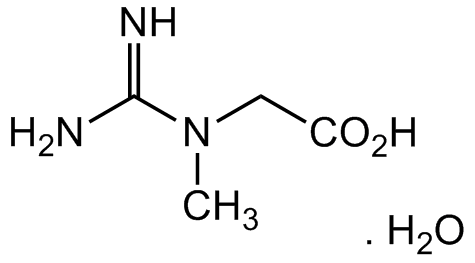Creatine . monohydrate
Product Code:
AG-CR1-3679
AG-CR1-3679
Regulatory Status:
RUO
RUO
Shipping:
Ambient
Ambient
Storage:
4°C
4°C
No additional charges, what you see is what you pay! *
| Code | Size | Price |
|---|
| AG-CR1-3679-G005 | 5 g | £40.00 |
Quantity:
| AG-CR1-3679-G025 | 25 g | £60.00 |
Quantity:
Prices exclude any Taxes / VAT
Stay in control of your spending. These prices have no additional charges, not even shipping!
* Rare exceptions are clearly labelled (only 0.14% of items!).
* Rare exceptions are clearly labelled (only 0.14% of items!).
Multibuy discounts available! Contact us to find what you can save.
This product comes from: Switzerland.
Typical lead time: 7-10 working days.
Contact us for more accurate information.
Typical lead time: 7-10 working days.
Contact us for more accurate information.
- Further Information
- Documents
- References
- Related Products
- Show All
Further Information
Alternate Names/Synonyms:
N-(Aminoiminomethyl)-N-methylglycine monohydrate
Appearance:
White solid.
CAS:
6020-87-7
EClass:
32160000
Form (Short):
liquid
Handling Advice:
Keep cool and dry.
InChi:
InChI=1S/C4H9N3O2.H2O/c1-7(4(5)6)2-3(8)9;/h2H2,1H3,(H3,5,6)(H,8,9);1H2
InChiKey:
MEJYXFHCRXAUIL-UHFFFAOYSA-N
Long Description:
Chemical. CAS: 6020-87-7. Formula: C4H9N3O2 . H2O. MW: 131.1 . 18.0. Synthetic. A nitrogenous organic acid that occurs naturally in vertebrates. Can be acquired through dietary consumption or formed from L-arginine, glycine and L-methionine in a multi-step reaction that occurs in the kidney and liver. High-energy reservoir for the rapid regeneration of ATP. Its main role is to facilitate recycling of adenosine triphosphate (ATP) primarily in muscle and brain tissue via the action of creatine kinase(s). Supplementation is investigated for the use in myopathies and enhancement of sports performance, primarily by increasing muscle mass. It is also investigated as a treatment of neuromuscular diseases, where it may aid in neuroprotection and by improving the cellular bioenergetic state. Antioxidant compound. Thermogenesis enhancer in beige adipocytes. Creatine cycling is important for thermogenesis and an altered creatine cycle could lead to obesity. Enhancer of energy expenditure through stimulation of mitochondrial ATP turnover.
MDL:
MFCD00071582
Molecular Formula:
C4H9N3O2 . H2O
Molecular Weight:
131.1 . 18.0
Package Type:
Plastic Vial
Product Description:
A nitrogenous organic acid that occurs naturally in vertebrates. Can be acquired through dietary consumption or formed from L-arginine, glycine and L-methionine in a multi-step reaction that occurs in the kidney and liver. High-energy reservoir for the rapid regeneration of ATP. Its main role is to facilitate recycling of adenosine triphosphate (ATP) primarily in muscle and brain tissue via the action of creatine kinase(s). Supplementation is investigated for the use in myopathies and enhancement of sports performance, primarily by increasing muscle mass. It is also investigated as a treatment of neuromuscular diseases, where it may aid in neuroprotection and by improving the cellular bioenergetic state. Antioxidant compound. Thermogenesis enhancer in beige adipocytes. Creatine cycling is important for thermogenesis and an altered creatine cycle could lead to obesity. Enhancer of energy expenditure through stimulation of mitochondrial ATP turnover.
Purity:
>98%
SMILES:
NC(N(C)CC(O)=O)=N.O
Solubility Chemicals:
Soluble in water (10mg/ml).
Transportation:
Non-hazardous
UNSPSC Category:
Biochemical Reagents
UNSPSC Number:
12352200
Use & Stability:
Stable for at least 2 years after receipt when stored at -20°C. Store solutions at -20°C in the dark.
Documents
References
Creatine: endogenous metabolite, dietary, and therapeutic supplement: J.T. Brosnan & M.E. Brosnan; Annu. Rev. Nutr. 27, 241 (2007) (Review) | Creatine as an antioxidant: P. Sestili, et al.; Amino Acids 40, 1385 (2011) (Review) | Creatine inhibits adipogenesis by downregulating insulin-induced activation of the phosphatidylinositol 3-kinase signaling pathway: N. Lee, et al.; Stem Cells Dev. 24, 983 (2015) | Genetic depletion of adipocyte creatine metabolism inhibits diet-induced thermogenesis and drives obesity: L. Kazak, et al.; Cell Metab. 26, 660 (2017) | Creatine fuels the thermic effect of feeding: A.R. Saltiel; Cell Metab. 26, 594 (2017) (Review) | Targeting thermogenesis in brown fat and muscle to treat obesity and metabolic disease: M.J. Betz & S. Enerbaeck; Nat. Rev. Endocrinol. (Epub ahead of print) (2017) (Review)
Related Products
| Product Name | Product Code | Supplier | 3-Guanidinopropionic acid | AG-CR1-3678 | AdipoGen Life Sciences | Summary Details | |||||||||||||||||||||||||||||||||||||||||||||||||||||||||||||||||||||||||||||||||||||||||||||
|---|---|---|---|---|---|---|---|---|---|---|---|---|---|---|---|---|---|---|---|---|---|---|---|---|---|---|---|---|---|---|---|---|---|---|---|---|---|---|---|---|---|---|---|---|---|---|---|---|---|---|---|---|---|---|---|---|---|---|---|---|---|---|---|---|---|---|---|---|---|---|---|---|---|---|---|---|---|---|---|---|---|---|---|---|---|---|---|---|---|---|---|---|---|---|---|---|---|---|---|



